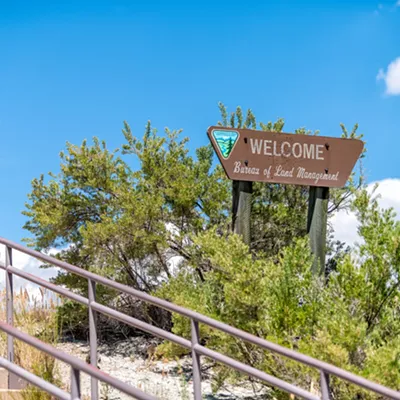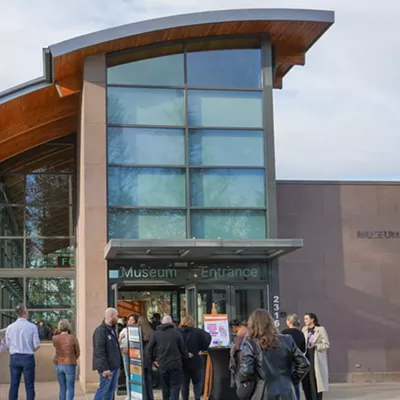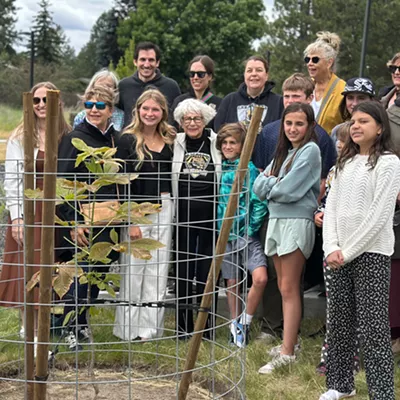It's one thing to have a river flowing through the middle of downtown. Lots of metropolises can claim that: Chicago, Portland -- hell, even Great Falls, Montana, has a river to call its own. It's quite another to have what we have here - an exhilarating display of basalt, gravity and rushing silvery-green water that pools decoratively alongside the Looff Carousel and the Opera House before racing free in a joyous tumult below the Monroe Street Bridge.
In June 2003, we ran an issue of The Inlander dedicated to the Spokane River and how it "defines us, sustains us and inspires us." Lorinda Knight, of the eponymous contemporary art gallery, was so intrigued that she put out the call and 16 artists responded - resulting in a two-month exhibition of widely varying visual interpretations. Far from being a blandly complacent display of "Close to Nature, Close to Perfect" boosterism, however, "The Spokane River and the Great Gorge Park" recognizes that it arrives at a crucial point in the river's history.
"The Spokane River has been named the sixth-most endangered river in the United States by American Rivers," says John Osborn, conservation chair for the Sierra Club's Upper Columbia region. "The river is at a real crossroads right now. There are a number of critical decisions being made over the next weeks and months that will determine whether the river lives or dies."
Representatives from the Friends of the Falls, another conservation group that is supporting the installment of the "Great Gorge Park" just beyond Peaceful Valley, took many of the artists on a field trip of the river last spring. Some responses, notably Nancy Peterfreund's photographs of the Ponderosa and yellow flowers flanking the banks of the Spokane River, along with Melissa Lang's sunny abstract "Pulse," elicit the shifting rays of sunlight, the glimmer of green water and even the smells of the river as it is right now, just a mile or two away from where we work, sleep and live.
Other pieces spring from the artists' often complicated reactions to the river. Take, for instance, Tom McClelland's sculpture of what could be a bronze rock, or even a heart, cut through by an elegant blue pipe representing the ancient Lake Missoula flood (which is what formed the Spokane River valley, the aquifer and much of the surrounding region). The shadows formed by twisting metal indicate violent circumstance; the blue ribbon suggests the flow of the eternal.
A Native American legend surrounding how the falls were made is the guiding principle behind more than a few of the works. As the story has it, Coyote fell in love with the chief's daughter but his love was unrequited, his request for her hand unanswered. Frustrated and lovelorn, Coyote wreaked havoc in the river -- in some versions, he puts down an enormous destructive paw, in others he hurls boulders -- in order to stop the passage of salmon and thereby hurt the chief and his people.
Several artists, including Kay O'Rourke and Rik Nelson, take the Coyote legend for their inspiration. O'Rourke's canvas of a manly Coyote lurking under the Monroe Street Bridge is perhaps the most direct representation -- a maiden languishes in cold, stony silence amid the waters while a vital, coppery salmon leaps into the sky.
Rik Nelson turns instead to Sherman Alexie's lyric interpretation of the legend "The Place Where Ghosts of Salmon Jump." A keening murmur of loss, alienation and anger, Alexie's poem becomes in Nelson's work a jumping-off place. Taking specific words from the Alexie poem, Nelson crafts his own, called "Concrete Ghost." An enormous wooden panel is engraved and emblazoned with not only the words of the new poem but also with metal salmon crafted out of recycled materials. A list of the ingredients Nelson used for his own vision says much about our disposable and advertising-ridden society: "Spray & amp; Wash Laundry Stain Remover, New Formula! Advanced Grease 'n Stain Removal bottle," "Lindsay Olive Company Calif. Ripe Pitted Olives lid, large."
Real flesh-and-blood salmon -- rather than metaphorical fish -- are at the heart of Kathleen Cavender's piece, "Prayer for the Salmon." Cavender was part of the group of artists who went on the Friends of the Falls field trip last spring.
"One of the things they told us just broke my heart and that is that the river was once completely full of salmon. And in a hundred years, they were all gone. In a lot of ways, the salmon's story is a metaphor for what we've done to Native American culture. Their religious life was based on the salmon, their social life -- tribes would come from all around to share in the wealth of salmon here," says Cavender. Her piece depicts spawning salmon -- all humpy and red and exhausted -- against which a dripping inset of a river landscape hints at grief while a garland of salmon eggs is a potent reminder of hope. "So the imagery is all about how we need to strive to bring back the salmon," Cavender says, "as well as our hopes for revitalization and that our efforts will be pleasing to the salmon."
Photographs by Dominic Arizona Bonuccelli hearken back to a time long before white men stalked these shores, while abstract pieces by Michelle Forsyth and Chris Watts bring an invigorating mathematical precision to the table. But perhaps the piece that most captures the sense of what this show is about is a simple canvas by Lanny De Vuono. The word "forever" floats above fluid blue, cornered by tufts of green riverbank. Perhaps not by accident, the dimensions of the piece mimic the size and shape of most contemporary headstones.
"It's so timely to be having this show now, with all these decisions about the river coming down in the coming weeks and months," says John Osborn. The gallery is hosting a fundraiser for the Sierra Club on Aug. 19, and interested parties can come and learn more about the river (for instance, how certain practices are causing the river to run at a dangerously low volume).
"The most powerful geographic entity in the region is the Spokane Falls; it is why the city exists," says Osborn. "We are robbing the river of its lifeblood and we can't continue to do so like we've been."
Publication date: 08/05/04
















